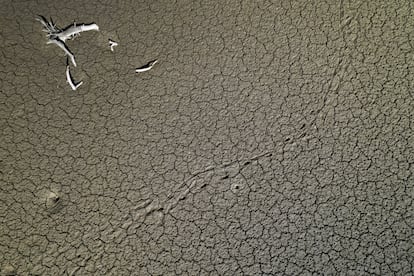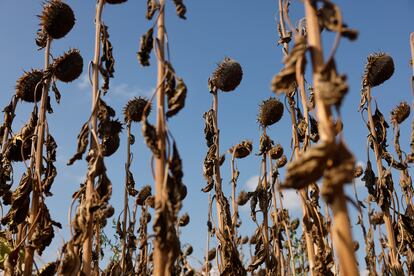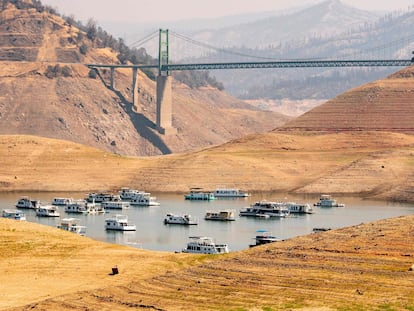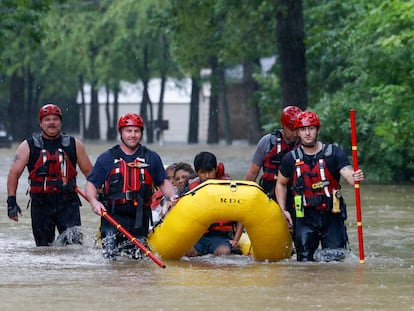Global warming: Extreme droughts 20 times more likely under current climate conditions
A new scientific report finds that weather phenomena affecting soil moisture are much more frequent than in the pre-industrial age


From the United States to China via Europe, the summer of 2022 was marked by drought across much of the Northern Hemisphere. Amid a climate crisis that is presenting its most damaging front in every corner of the planet, the question is almost inevitable: is global warming the root cause of the issue? A group of scientists specializing in the attribution of extreme weather phenomena to climate change – the World Weather Attribution (WWA) – presented a study on Wednesday in which they present evidence that the unusually high temperatures recorded in June, July and August were the primary cause of the extraordinary dryness of the soils in the affected areas. The researchers conclude that human-induced climate change has made these extremely dry conditions at least 20 times more likely in the extratropical region of the Northern Hemisphere. Scientists estimate that at the current level of warming, a drought of this magnitude and geographical extent may occur once every 20 years. By contrast, in the absence of climate change, it would be expected to happen once every 400 years.
This summer’s global warming-fueled drought resulted in significant economic and ecological impacts in the Northern Hemisphere, but these issues were especially acute in West-Central Europe, the researchers noted. Among these damaging effects was a decrease in crop yields, which has further accentuated the international food cost and security crisis that the world is experiencing due to the war in Ukraine.
In order to establish links to climate change, the WWA scientists focused their research on the so-called agricultural and ecological drought, which is related to a lack of moisture in soils that has direct consequences on the growth and development of vegetation. In the report’s findings, it was concluded the that variations in rainfall volume were not the determining factor in this case, but rather that “the strong increase in high temperatures” was to blame for the increased drought.
The analysis focuses on two regions. In the case of the extratropical Northern Hemisphere, the researchers concluded that “human-induced climate change made the observed soil moisture drought much more likely, by a factor of at least 20 for the root zone soil moisture,” which corresponds to the first meter of soil. In West-Central Europe specifically, global warming has made a drought like the one experienced this summer between three to four times more likely. The report, which was compiled by scientists from Switzerland, India, the Netherlands, France, the United States and the United Kingdom, states that “the dry conditions observed in 2022 over both regions would have been less likely to occur at the beginning of the 20th century”, when greenhouse gas emissions generated by human industrial activity were far lower than they are now.
Friederike Otto, a climatologist and senior lecturer at the Grantham Institute for Climate Change and the Environment at Imperial College London and a co-founder of the WWA, explains that the study attempts to answer a question posited in other reports of this type: “What role has climate change played in this extreme phenomenon?” To try and provide an answer, they calculate the probabilities of a specific event - such as a heatwave, floods or a drought like that of this summer - occuring before the current climate crisis was triggered due to the burning of fossil fuels.
The scientific community is in broad agreement that the earth has warmed by about 1.2 degrees Celsius compared to pre-industrial levels. The WWA researchers calculate that in today’s climate, a severe drought event like the one in 2022 now occurs once every 20 years. Scientists have issued multiple warnings that temperatures will continue to rise over the coming decades, leading to an increase in ecological and hydrological droughts, something the United Nations Intergovernmental Panel on Climate Change emphasized in its most recent major report.

Linked events
The summer just ended was the hottest recorded in Europe since at least 1880 – when reliable temperature data began – as confirmed a few weeks ago by the European Commission’s Copernicus Climate Change Service. In the WWA attribution study for the 2022 drought, the researchers say the extreme heat conditions were responsible for more than 24,000 deaths in Europe. High temperatures led to water shortages, massive forest fires and reduced harvests. “During the summer, fires in Europe were the worst on record, China issued its first national drought alert and more than half of the United States was in drought,” the report concluded.
The impact of the drought on food security is one of the issues that most concerns the authors of the report. “The drought in the Northern Hemisphere has had an impact on food prices, which had already been affected by the war,” said Maarten van Aalst, director of the International Red Cross Red Crescent Climate Centre and a professor at the Faculty of Geo-Information Science and Earth Observations at the University of Twente in the Netherlands. Compounding the food security crisis is the extreme heat experienced in India and Pakistan in March and April, which has also been attributed to climate change, or the recent floods in Pakistan. “All these extreme events combined add to the stress on international food markets,” noted Otto.
“The impacts of climate change are coming faster than expected,” said van Aalst, who is also an expert in disaster management. As such, he points to the need for countries to invest in adaptation so that populations can weather an increasing number of natural disasters, in addition to cutting greenhouse gas emissions to limit warming as much as possible.
Tu suscripción se está usando en otro dispositivo
¿Quieres añadir otro usuario a tu suscripción?
Si continúas leyendo en este dispositivo, no se podrá leer en el otro.
FlechaTu suscripción se está usando en otro dispositivo y solo puedes acceder a EL PAÍS desde un dispositivo a la vez.
Si quieres compartir tu cuenta, cambia tu suscripción a la modalidad Premium, así podrás añadir otro usuario. Cada uno accederá con su propia cuenta de email, lo que os permitirá personalizar vuestra experiencia en EL PAÍS.
¿Tienes una suscripción de empresa? Accede aquí para contratar más cuentas.
En el caso de no saber quién está usando tu cuenta, te recomendamos cambiar tu contraseña aquí.
Si decides continuar compartiendo tu cuenta, este mensaje se mostrará en tu dispositivo y en el de la otra persona que está usando tu cuenta de forma indefinida, afectando a tu experiencia de lectura. Puedes consultar aquí los términos y condiciones de la suscripción digital.
More information
Últimas noticias
There is as much life left to discover on planet Earth as that which is already known
Dozens presumed dead, around 100 injured in fire at Swiss Alps bar during New Year’s celebration
Is porn for women different from conventional porn? We spoke to those who make it
Cartagena de Indias is sinking: What can the city do to mitigate it?
Most viewed
- Reinhard Genzel, Nobel laureate in physics: ‘One-minute videos will never give you the truth’
- David King, chemist: ‘There are scientists studying how to cool the planet; nobody should stop these experiments from happening’
- Sinaloa Cartel war is taking its toll on Los Chapitos
- Oona Chaplin: ‘I told James Cameron that I was living in a treehouse and starting a permaculture project with a friend’
- The Interoceanic Train, the Mexican alternative to the Panama Canal










































